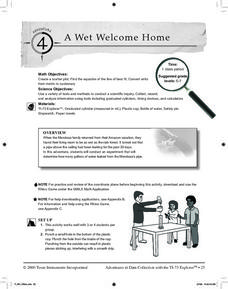Curated OER
Measuring Liquid Volume & Reading Thermometers
In this liquid volume worksheet, students first practice measuring liquid volume by determining what volume is indicated on each of the graduated cylinders in milliliters for the first nine problems. Then they determine the temperature...
Curated OER
Significant Figures and Measurement
In this science learning exercise, students draw several markings on a ruler or graduated cylinder or thermometer to get each of the correct measurements. Then they state what place the marking indicates and the number of significant...
Curated OER
Reading Graduated Cylinders
In this cylinder worksheet, middle schoolers read calibrated cylinders. They determine the precision on each cylinder and name the represented milliliters. This two-page worksheet contains twelve problems.
Curated OER
Volume of Irregular Objects
Fifth graders experiment using a Meniscus. In this volume lesson, 5th graders identify the volume of irregular objects using the process of water displacement. Students record data and draw conclusions.
Curated OER
The Metric System
Learners practice converting metric measurements by completing the activities listed in this instructional activity. They first practice measuring common objects. They then convert metric measurements using the included worksheet.
Curated OER
A Wet Welcome Home
Students investigate data collection and analysis. In this Algebra I activity, students create a scatter plot and find the equation of best fit in a simulation of a leaking water pipe.
Curated OER
A Plop and Fizz
Seventh graders perform an experiment to determine the effect of temperature on reaction rates. In this chemistry lesson, 7th graders take measurements and record data. They create a graph and analyze results.
Curated OER
Math is Everywhere!
In this everyday math skills pretest, learners answer ten multiple choice questions based on their knowledge of everyday math skills such as estimation, addition, and measurement.
Curated OER
What Does Waste Do to a River?
Students develop a graphic way of visualizing the concept of a million by utilizing what had happened to the Nashua River due to the dumping of raw sewage in 1962.








